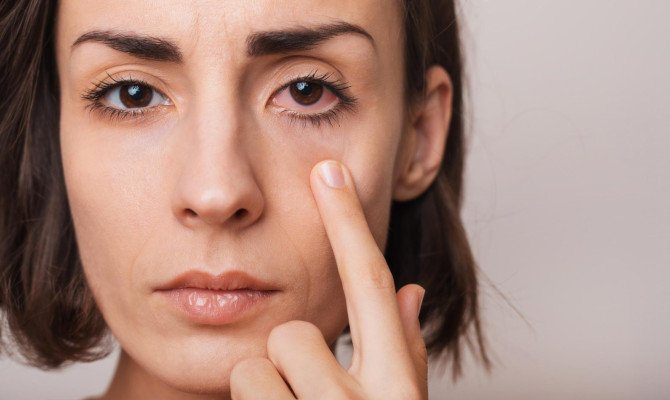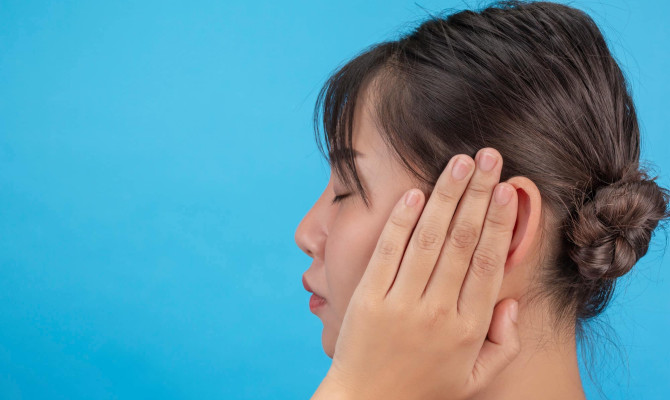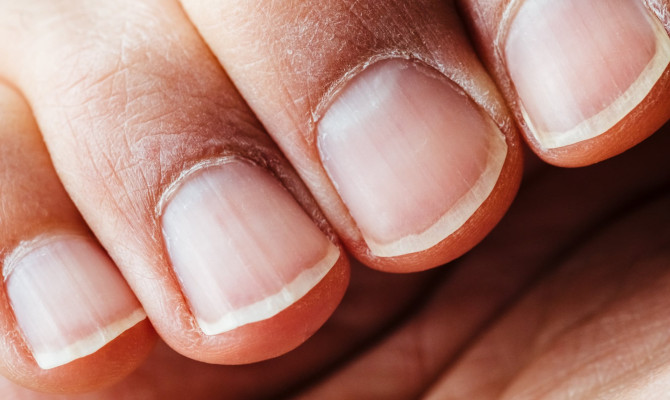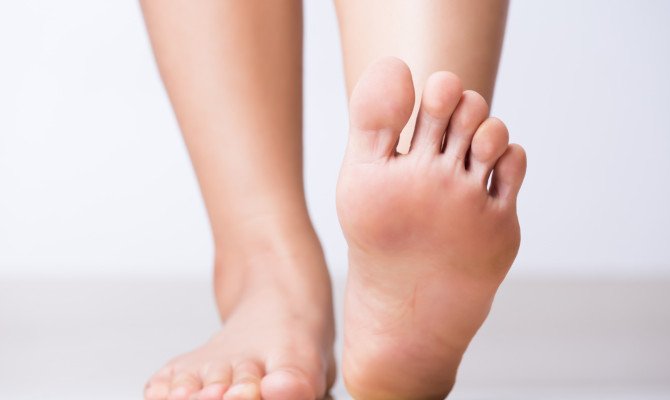Celiac disease: Understanding the Causes, Symptoms, and Treatment Options

- Celiac Disease
- 14 Aug 2023
Overview
What is Celiac disease ?
An ongoing autoimmune condition that affects the digestive tract is called celiac disease. Gluten, a substance present in wheat, barley, and rye, is what sets it off.
Wheat, barley, and rye all contain the protein gluten, as do many processed foods made from these cereals, including pasta, bread, and cereal. Gluten makes the immune system react in individuals with celiac disease. Damage like this can prevent minerals from food from being absorbed, which can result in malnutrition and other health issues. 1Overview | Researched based study from Celiac.org

Symptoms
What are the symptoms ?
Children and adults may experience various and unique celiac disease signs.
Children’s symptoms could include
- Persistent vomiting
- Bloating and discomfort in the abdomen 1Symptoms | Researched based study from Celiac.org
- Vomiting
- Constipation
- Short stature and poor development
- Postponed adolescence
- Delayed puberty 1Symptoms | Researched based study from Celiac.org
- Headaches
- Foul smelling stools
- Fatigue
- Irritability or behavioural changes
- Defects in dental enamel 1Symptoms | Researched based study from Celiac.org
- Failing to thrive
Adult symptoms could consist of the following
- Bloating and discomfort in the abdomen 1Symptoms | Researched based study from Celiac.org
- Persistent vomiting
- Fatigue
- Anxiety or depression
- Aching joints
- Blisters or a skin reaction 1Symptoms | Researched based study from Celiac.org
- Joint pain
- Missed periods
- Weight loss
- Miscarriage or infertility
- Iron deficiency anemia 1Symptoms | Researched based study from Celiac.org
- Fractures or osteoporosis. 1Symptoms | Researched based study from Celiac.org
Dermatitis Herpetiformis
What is Dermatitis Herpetiformis ?
It is important to remember that some individuals might not exhibit any signs. Speaking with a healthcare provider is crucial if you think you or your child may have the illness.
- A Dermatitis Herpetiformis (DH) skin condition is strongly related to celiac disease. DH is a persistent, excruciatingly itchy, blistering rash that usually affects the scalp, back, buttocks, elbows, and knees.1Dermatitis Herpetiformis | Researched based study from Celiac.org
- The rash typically appears identical in the same spot on both sides of the body. The skin reaction may worsen if you eat gluten.
- After beginning a gluten-free diet, the rash will typically get better within a few weeks or months. However, it might take longer for the skin to recover completely. 1Dermatitis Herpetiformis | Researched based study from Celiac.org
Causes
What are the Causes?
- When a person eats gluten, their immune system attacks the small intestine’s lining, especially the villi, which are tiny protrusions that resemble fingers and can cause irritation and inflammation. The villi must function correctly for the body to absorb nutrients properly. 2Causes | Researched based study from NHS.uk
- The precise cause is unclear, but it is thought to result from a genetic and environmental factors. People with a family history of the condition are more likely to get it.
- Viral infections, gastrointestinal infections, and specific medical procedures like surgery, pregnancy, and childbirth are examples of environmental variables that may cause celiac disease to develop. 2Causes | Researched based study from NHS.uk
Understanding that celiac disease is an autoimmune condition rather than a food allergy or intolerance is critical. Consuming gluten can set off an immune reaction and harm the small intestine in people with celiac disease, even in small quantities.
Vulnerability
Who is at risk of getting Celiac disease?
Family background
- A person’s chance of contracting the illness is increased by having a close relative with it.
Genetics
- The HLA-DQ2 and HLA-DQ8 genes, among others, are linked to a greater susceptibility to the illness. 3Vulnerability | Researched based study from Niddk.nih.gov
Age
- Can develop at any age, but individuals between the ages of 30 and 60 are the ones who are most frequently diagnosed with it.
Additional inflammatory diseases
- A higher chance exists in people with autoimmune diseases like type 1 diabetes, thyroid disease, or liver disease.
Digestive tract diseases
- Some studies show that those genetically prone to celiac disease may experience the condition’s onset after contracting gastrointestinal infections like rotavirus or norovirus. 9Vulnerability | Researched based study from Nlm.nih.gov
Specific health issues
- Those with Down, Turner, or Williams syndrome have a higher chance.
Pregnancy and childbirth
- According to the research, women genetically predisposed to celiac disease may experience the condition’s onset during pregnancy and childbirth. 10Vulnerability | Researched based study from Nlm.nih.gov
Diagnosis
How is Celiac disease diagnosed?
A physical evaluation and medical history
- The medical professional will inquire about your symptoms and medical background and perform a physical evaluation to check for signs.
A blood testing
- Specific antibodies that are produced in reaction to gluten can be found through blood tests. Increased amounts of these antibodies may be a sign of the illness.4Diagnosis| Researched based study from Nlm.nih.gov
- The procedures include complete blood count (CBC), liver function tests, cholesterol levels, etc.
- Blood studies can also check for nutrient deficiencies, which can be brought on by malabsorption, including iron, calcium, and vitamin D.
Intestinal biopsy
- An intestinal biopsy is a standard method for identifying celiac disease. Using an endoscope, a small tissue sample is removed from the small intestine and examined.4Diagnosis| Researched based study from Nlm.nih.gov
- Additional testing might be required in some circumstances, such as genetic testing or the gluten challenge, which entails ingesting gluten before testing.
It is crucial to remember that a person must consume gluten in their diet for the tests to be accurate. As a result, people who think they might have the condition should wait to cut out gluten before getting checked.
Skin biopsy
- A skin biopsy is performed in people with Dermatitis Herpetiformis (DH).
Endoscopy
- During an endoscopy, a thin tube is inserted through the mouth and down into the intestine when the findings of the previous tests are unclear. It has a camera to inspect the interior components and villi damage. 4Diagnosis| Researched based study from Nlm.nih.gov
Management
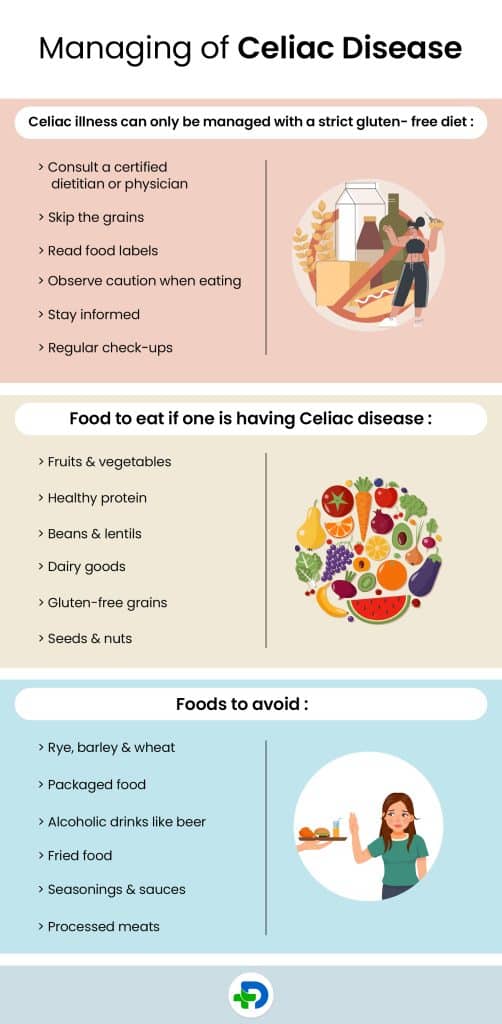
Managing Celiac disease
Celiac illness can only be managed with a strict gluten-free diet. The following are some methods for treating the condition:
Consult a certified dietitian or physician.
- Verify the prognosis and create a gluten-free eating strategy.
Skip the grains
- Eliminate all gluten-containing foods from your diet, including processed foods, bread, noodles, cereals, and other baked goods. 5Treatment| Researched based study from Nhs.uk
Read food labels
- Recognize hidden sources of gluten on product labels, such as modified food starch, malt, and hydrolyzed vegetable protein. 5Treatment| Researched based study from Nhs.uk
Observe caution when eating.
- Exercise caution when travelling or dining out because cross-contamination can happen in restaurants and other eateries. Ask about ingredients and cooking techniques, and ensure the staff knows your dietary restrictions.
Stay informed.
- Keep up with discoveries in the treatment of celiac disease, including potential drugs and therapies that might be made accessible in the future.
Regular check-ups
- Schedule routine check-ups to track your symptoms, nutritional state, and adherence to a balanced diet. 5Treatment| Researched based study from Nhs.uk
Diet
Food to eat if one is having Celiac disease
Fruits and vegetables
- Fresh fruits and veggies should make up most of your diet because they are naturally gluten-free.
Healthy protein
- You can include meats, poultry, seafood, and eggs.
Beans and lentils
- Foods rich in protein and fiber include lentils, chickpeas, and black beans.6Diet| Researched based study from Niddk.nih.gov
Dairy goods
- Milk, cheese, and yoghurt are among most dairy products that are gluten-free. To ensure that gluten has not been added, it is crucial to study labels.6Diet| Researched based study from Niddk.nih.gov
Gluten-free grains
- Numerous grains, including buckwheat, maize, quinoa, and rice, are gluten-free. Look for gluten-free versions of bread, pasta, and other grain-based goods.
Seeds and nuts
- These can be healthy and satisfying snacks in addition to meals. 6Diet| Researched based study from Niddk.nih.gov
Foods to avoid
Rye, barley, and wheat
- All types of these foods, such as bread, pasta, cereal, and baked products, should be avoided.6Diet| Researched based study from Niddk.nih.gov
Packaged food
- Numerous packaged and processed meals include gluten as a main ingredient or a secret source.
Alcoholic drinks like beer
- All types of beer, including lager contain gluten and should be shunned.6Diet| Researched based study from Niddk.nih.gov
Fried food
- Foods fried in the same oil as gluten-containing foods should also be avoided, as should flour-coated foods.
Seasonings and sauces
- Many seasonings and sauces include salad dressings, teriyaki sauce, and soy sauce. Select options or come up with your own.6Diet| Researched based study from Niddk.nih.gov
Processed meats
- The presence of gluten as an ingredient or filler can be found in some processed foods like sausages, hot dogs, and deli meats. 6Diet| Researched based study from Niddk.nih.gov
Complications
Complications of Celiac disease
Malnutrition
- Malnutrition may come from nutrient malabsorption brought on by slight intestine damage.
Osteoporosis
- The condition can hinder calcium and vitamin D intake, increasing the risk of osteoporosis and bone fractures.
Miscarriage and infertility
- Women with neglected illnesses may have trouble getting pregnant or are more likely to miscarry.
Anemia
- It may result in iron deficiency anemia, producing symptoms like weakness and exhaustion.
Intolerance to lactose
- The damage to the small intestine can make it difficult to digest lactose. 8Complications| Researched based study from Nlm.nih.gov
Neurological conditions
- Rarely, neurological conditions such as seizures, migraines, and neuropathy can develop due to celiac disease.
High chance of some cancers
- According to some evidence, Untreated celiac disease may increase the chance of developing certain cancers, including lymphoma and small intestine cancer.7Complications| Researched based study from Nlm.nih.gov
Takeaway
Key Takeaways
- An autoimmune condition called celiac disease. There is currently no known method for preventing it.
- The only way to treat the condition is by strictly avoiding gluten in your diet.
- Even in the absence of symptoms, screening may be helpful for those who are more likely to acquire the disease.
- Early detection and intervention can reduce problems and enhance long-term results.
Any feedback on this article?
 This Articles content was accurate
This Articles content was accurate Very Informative Article
Very Informative Article I have a question or a comment
I have a question or a comment
 This article contains inaccurate content
This article contains inaccurate content This article was not helpful
This article was not helpful I have a question or a comment
I have a question or a comment
We appreciate your helpful feedback!
Checkout our social pages
References
-
Celiac Disease Foundation
Symptoms of Celiac Disease | Introduction | Symptoms
-
National Health Service
Coeliac disease | Causes
-
National Institute of Diabetes and Digestive and Kidney Diseases.
Symptoms & Causes of Celiac Disease | Risk Factors
-
National Library of Medicine
Celiac disease: Prevalence, diagnosis, pathogenesis and treatment | Diagnosis
-
National Health Service
Coeliac disease | Treatment
-
National Institute of Diabetes and Digestive and Kidney Diseases.
Celiac Disease | Diet
-
National Library of Medicine
Small bowel neoplasia in coeliac disease | Complications
-
National Library of Medicine
Complications of coeliac disease: are all patients at risk?
-
National Library of Medicine
A viral trigger for celiac disease | Risk
-
National Library of Medicine
Coeliac disease and pregnancy outcomes | Complications















